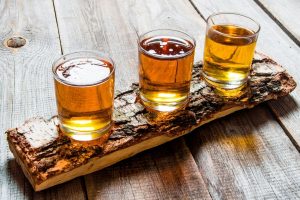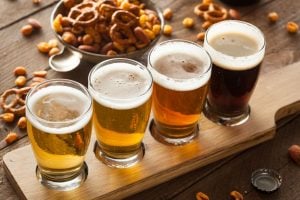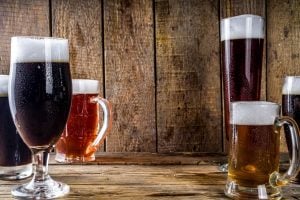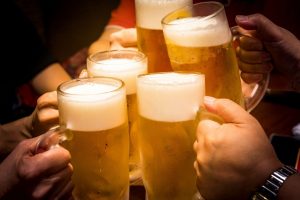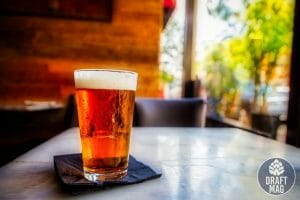Radler vs Shandy: Two Similar Yet Different Summer Beers
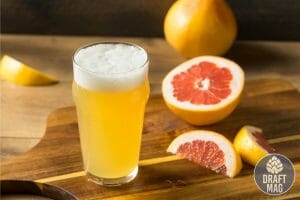 Radler vs shandy is a battle with no clear winner.
Radler vs shandy is a battle with no clear winner.
But what precisely is the difference between these two pleasant beverages?
Lemons, oranges, limes, and grapefruits are making their way into today’s craft beer market with regularity and epically delicious outcomes.
Citra and Cascade hops are innately fruity, but brewers and home entertainers are increasingly adding genuine zest, juice, or peel from citrus fruits to their already zesty beverages – a.k.a. shandies and Radler. In this article, we’ll compare the two drinks.
Comparison Table
Many modern brewers use these two terms interchangeably. However, they are two separate entities. Let’s compare the two beverages:
| Shandy | Radler | |
| Flavors | A shandy is a broader term that includes ginger beer and fresh juice variations. | Only citrus-based flavors are usually referred to as Radler. |
| Preparation | It is traditionally made only using lemonade | A Radler can be made with any combination of beer and fruit juice |
| Origin | The Shandy was created in the 1850s in the United Kingdom. | Radlers are German lemon beers. |
| Carbonation | It can be either carbonated or non-carbonated. | It is carbonated. |
| Alcohol content | Shandies contain 4.2 to 4.5 percent ABV | Radler contains two to 4.5 percent ABV |
What Are the Differences Between Radler and Shandy?
The main difference between Radler and Shandy is that a Radler is made of beer and various fruit juices while a Shandy is only made with lemonade. Radlers originated from Germany while Shandies were made popular in the United Kingdom.
What Is Radler Best For?
Radler is best for spicy dishes like buffalo wings, fajitas, and hot curries. This drink is also suited with rich breakfast dishes like bacon and eggs benedict.
– Features
Let’s look into some of the features of Radler:
– Alcoholic Content
Radlers are drinks meant to quench your thirst rather than give you a buzz. Commercially made, Radler has two to 4.5 percent ABV. Brewers, on the other hand, like to develop stronger drinks. Therefore you can find Radlers with higher alcohol content than most traditional beers.
– Flavor
This beer is well-balanced and lightly carbonated. It has a sweet and delicate flavor with a fruity undertone. It’s pleasantly sweet and tangy yet keeps enough of a beer backbone to remain in balance, thanks to a combination of lager and fruit juice.
– Ingredients
It’s essentially a malty, effervescent combination of wheat or lager beer with lime, grapefruit, orange juice, or classic lemonade. You can find Zitronenlimonade and Munich Helles in a typical Radler. Munich Helles is a sweeter German lager, whereas zitronenlimonade is a German lemon-flavored soda.
– Best Beers To Use
Pilsners, pale ales, and light ales are the best beer kinds for making homemade Radlers. Crux Parkway Pilsner, Deschutes Brewery’s Mirror Pond Pale Ale, or Bone Light from Boneyard are some options for your Radler cocktail.
– Examples
Here are a few best Radlers to try this summer:
-
Moosehead Radler
Moosehead creates a delectable blend of traditional Radler and grapefruit, lemon, and grape juices. The result is a four percent ABV beverage presented in the classic green bottle.
-
Stiegl Radler
Stiegl Radler is an exceptional blend of fresh grapefruit juice and Stiegl-Goldbrau. This hazy beverage with two percent alcohol by volume (ABV) is extremely refreshing, making it a popular choice for hot summer days.
-
Amstel Radler
Amstel is combined with fresh lemon juice to make the new Amstel Radler. It has 3 percent alcohol by volume. The cocktail has 40 percent actual lemon juice and a 60 percent Amstel Lager ratio.
-
Ginger Lemon Radler
The Ginger Lemon Radler is a classic combination of beer and soda (or lemonade). It is a light, thirst-quenching beverage perfect for summer.
– Preparation
Mix any cold light beer in a 70:30, 50:50, or 75:25 ratio with lemonade or your favorite lemon-lime or grapefruit soda. Using a lager or wheat beer is one of the more practical solutions for new brewers.
To make a traditional German Radler, combine equal parts light-colored, hoppy beer, and lemon-lime flavored citrus soda. Pilsner is the best beer for this purpose. Fill glass fully or halfway with lager, depending on your preference, and top it up with handmade carbonated lemonade.
After you’ve mastered this recipe, try experimenting with mandarin, grapefruit, or mango flavors. The only limitation while preparing Radler is the amount of sugar since Radler isn’t sticky sweet.
– Radler: Beer Cocktail History
A Radler is a German beer developed in the early twentieth century when cyclists were seeking a refreshing and hydrating beverage to sip after long bike rides. It is a beer-based beverage with a low alcohol content (sessionable).
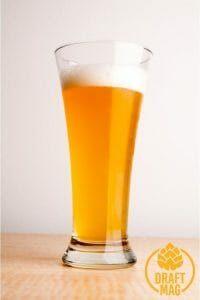 These are also known as German lemon beer. A typical Radler is a malty, fizzy beverage prepared with beer and lemonade, sparkling water, or lemon-lime soda.
These are also known as German lemon beer. A typical Radler is a malty, fizzy beverage prepared with beer and lemonade, sparkling water, or lemon-lime soda.
The cocktail started as a half beer half lemonade drink, but it has since grown into a drink that you may mix with various fruit juices. Austria’s Stiegl Radler, produced with grapefruit juice, is one of the most popular Radlers on the planet.
The Radler category currently includes different taste varieties in Central Europe and Germany.
The Stiegl Brewery in Austria, for example, manufactures Radlers with raspberry and grapefruit in addition to lemon soda. In Berlin, a “Potsdamer” is essentially a Radler with a shot of raspberry syrup.
What Is Shandy Best For?
Shandy is best for savory meats like cured meats and hams. This drink is also suited for creamy cheese like Brie.
– Features
Here are the features of shandy:
– Alcohol Content
It will take a lot of Shandy to get a buzz since this cocktail can be classified light. Most commercial shandies have an ABV of 4.2 to 4.5 percent. Essentially, the ABV is determined by the beer-to-juice ratio. If you choose a shandy with a 50:50 ratio, your drink will have half the ABV of a typical beer.
– Flavor
It smells like zesty lemon, and the first sip gives you a dry and fizzy citrus explosion, backed up by enough sweet malt to keep things from being a puckerfest. This delightful summer sipper is dry, citrusy – ultimately refreshing and chilling.
– Ingredients
Although many breweries now offer a kind of summer shandy that is merely lemon- or citrus-flavored, summer shandy is traditionally brewed with lemonade. In some cases, lemon-lime soda is substituted for lemonade, and in others, ginger beer is used.
– Best Beer To Use
The best shandies are made using wheat beer and light lagers. Pilsner is also a popular base for shandies. If you enjoy a hoppy IPA, you can use a lighter version with a shandy, but you won’t want to use a dark or stout. The quality of the lemonade is just as crucial as the quality of the beer.
– Examples
Shandies are simple to make beverages that will revolutionize your thoughts about beer-based drinks. Here are a few to get you started:
-
Leinenkugel Summer Shandy
There are a few various shandies made by Leinenkugel’s, but the original Summer Shandy has to be the greatest. It’s a Weiss beer (or wheat beer) mixed with lemonade – not too acidic, not too sweet. It has the ideal amount of sweetness and tartness to make a light, delicious summer treat.
-
UFO Pink Lemonade Shandy
Harpoon Brewery’s UFO Beer makes a Pink Lemonade Shandy, which is exactly what it sounds like — a combination of pink lemonade and light beer. It can also be frozen to make a delicious and refreshing slushie.
-
Curious Traveler
The Traveler Beer Company’s Curious Traveler is a traditional European Shandy. The Curious Traveler is an American craft wheat ale with lemon and lime added to emphasize the citrus fragrance and flavor. The beer’s alcohol content is only 4.4 percent.
-
UFO Big Squeeze Shandy
UFO Big Squeeze has a 4.5 percent alcohol level. Big Squeeze has a strong grapefruit flavor with a hint of sourness and citrus notes. It has an apricot or orange tint when poured into a glass.
– How To Make a Shandy
Choose a beer you enjoy, such as wheat beer, light lager, or a pilsner. Then squeeze lemons to make lemonade. Fill your glass with six ounces of beer. Add six ounces of lemonade to finish.
If you prefer store-bought lemonade, try to find one with the lowest sugar content. That way, you won’t end up with an overly sweet beverage. Pour the beer into a chilled pint glass and top it off with lemonade. Finally, a lemon slice will be a lovely addition to your drink.
The amounts of beer and lemonade in a shandy are usually equal, but they might vary. You may want to use less lemonade with a wheat beer, whereas with a light lager, you may want to use more. Personal preference will most likely differ depending on the style of beer.
You may also prepare them by purchasing beer and soda in bottles. Pour them into a chilled pint glass and garnish with a lemon slice. If you prefer lime, you can use that instead.
– Shandy: Refreshing Beer Cocktail
Shandy is a refreshing citrus beer. A shandy is made by combining beer and zesty lemon-lime soda in equal proportions. It is a famous British pub cocktail that you may readily make with your favorite beer and soda.
However, you should avoid mixing stouts with lemonade since their flavors clash.
Since beer makes up half of the drink, shandies are alcoholic and gluten-free only if you use gluten-free beer. The alcohol concentration of bottled or canned shandies, on the other hand, is often relatively low.
It’s commonly a blond lager (Hefeweizen or Pils) or wheat beer with lemon or lime flavor. It can either be carbonated or non-carbonated. It can, however, be wider in scope, including ginger beer, grapefruit, apple, ginger ale, or orange juice.
Endnote
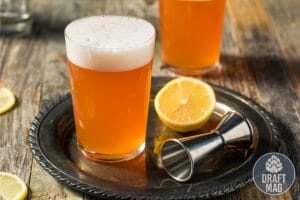 Radler and shandy are the best options you may find if you enjoy beer but need to recharge with a low-alcohol beverage.
Radler and shandy are the best options you may find if you enjoy beer but need to recharge with a low-alcohol beverage.
Nowadays, you may buy commercial shandies and Radlers or easily make them yourself. Make lemonade with water, fresh lemons, and sugar, and serve it with a light lager or wheat beer.
To get the most out of your drink, add a slice of lemon to the top, and voila- you got yourself a refreshing treat!

